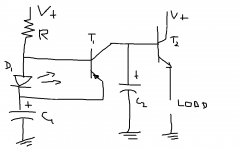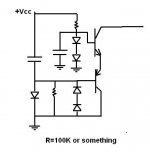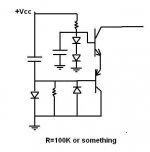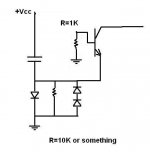I need to detect when the voltage drops in a battery powered circuit. NOT to a certain voltage, but rather when the voltage quickly sags.
I want/need/require to do this using discrete transistors [NO ICs!] and as cheaply as possible.
I was thinking of a resistor and capacitor [in series] across the power - with a PNP transistor wired;
base to V+ side of the resistor
emitter to resistor/capacitor junction
but no luck...............should I 'tie' the collector to ground via a resistor - say 100K?
And get the signal from the collector that way?
The voltage in the circuit is up to 48V - any risk of blowing the transistor?
Thanks!
Ken
I want/need/require to do this using discrete transistors [NO ICs!] and as cheaply as possible.
I was thinking of a resistor and capacitor [in series] across the power - with a PNP transistor wired;
base to V+ side of the resistor
emitter to resistor/capacitor junction
but no luck...............should I 'tie' the collector to ground via a resistor - say 100K?
And get the signal from the collector that way?
The voltage in the circuit is up to 48V - any risk of blowing the transistor?
Thanks!
Ken
What sort of an output do you need?
Simplest is a cap and a LED.
Cap from +Vcc to cathode of LED...anode to ground...protection circuitry: a diode in parallel with LED: anode to cathode.
🙂
Simplest is a cap and a LED.
Cap from +Vcc to cathode of LED...anode to ground...protection circuitry: a diode in parallel with LED: anode to cathode.
🙂
Hi,
I think what you are looking can do it with a voltage comparator op amp. You set the limit and if the voltage fall below it will set and output. You can use an led to indicate when you have a voltage down. Do a Google "voltage comparator op amp" and you will find a lots of web side explaining it.
I think what you are looking can do it with a voltage comparator op amp. You set the limit and if the voltage fall below it will set and output. You can use an led to indicate when you have a voltage down. Do a Google "voltage comparator op amp" and you will find a lots of web side explaining it.
What sort of an output do you need?
Simplest is a cap and a LED.
Cap from +Vcc to cathode of LED...anode to ground...protection circuitry: a diode in parallel with LED: anode to cathode.
🙂
yaaaaaaaaaaaaaa BUT how to detect the voltage drop?
Just need 'some' signal - WHEN the voltage drops.
Ie
zero v - no drop
some V - drop
Hi,
I think what you are looking can do it with a voltage comparator op amp.
Yes, BUT the requirment is NO chips, NO op-amps, NO ICs 🙂
only discrete solid-state - transistors
I tried open collector but got nothing............... 🙁
I'll try connecting the collector via 100k resistor to ground, and see if I get something from the collector.................
I'll try connecting the collector via 100k resistor to ground, and see if I get something from the collector.................
The easiest, cheapest and most simple solution involves an Op Amp.I need to detect when the voltage drops in a battery powered circuit. NOT to a certain voltage, but rather when the voltage quickly sags.
I want/need/require to do this using discrete transistors [NO ICs!] and as cheaply as possible.
An LM358 starts at U$0.22 dropping to U$0.10 bulk.
Care to reconsider?
Please answer:
1) range of voltages to be measured.
2) voltage drop to be detected.
3) knowing the approximate period or duration would help
This detects instantaneous (here meaning all the time) load current, not exactly the same of what you are asking.I was thinking of a resistor and capacitor [in series] across the power - with a PNP transistor wired;
base to V+ side of the resistor
emitter to resistor/capacitor junction
but no luck...............should I 'tie' the collector to ground via a resistor - say 100K?
And get the signal from the collector that way?
Will trigger at a set total current value , catching only relatively gross ones.
Again, not the same as detecting a drop in supply voltage.
Which transistor?😕The voltage in the circuit is up to 48V - any risk of blowing the transistor?
So far we have selected no one.

many thanks to all
I get the stupid b*gger of the day award
It does work, as I 1st outlined.................some days, one should NOT do electronics!
The LED limits the voltage across T1 BE, and blocks reverse voltage flow when the voltage drops, keeping the V across the cap.
So when V+ drops, T1 turns on and hence T2 turns on - driving the load. C2 stretches the 'pulse'.

I get the stupid b*gger of the day award
It does work, as I 1st outlined.................some days, one should NOT do electronics!
The LED limits the voltage across T1 BE, and blocks reverse voltage flow when the voltage drops, keeping the V across the cap.
So when V+ drops, T1 turns on and hence T2 turns on - driving the load. C2 stretches the 'pulse'.

Last edited:
'The LED limits the voltage across T1 BE,...'
I feel the other way, I may be wrong.
Gajanan Phadte
I feel the other way, I may be wrong.
Gajanan Phadte
'The LED limits the voltage across T1 BE,...'
I feel the other way, I may be wrong.
Gajanan Phadte
It does, and for this application it is a good thing. T1 already amplifies the Vd, so anything over [say] 2V is not necessary.
- Status
- Not open for further replies.
- Home
- General Interest
- Everything Else
- Detecting Voltage Drop



